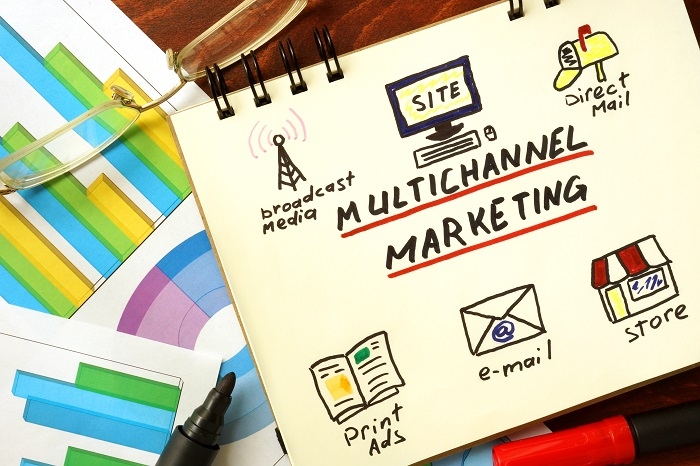
 Data Structure
Data Structure Networking
Networking RDBMS
RDBMS Operating System
Operating System Java
Java MS Excel
MS Excel iOS
iOS HTML
HTML CSS
CSS Android
Android Python
Python C Programming
C Programming C++
C++ C#
C# MongoDB
MongoDB MySQL
MySQL Javascript
Javascript PHP
PHP
- Selected Reading
- UPSC IAS Exams Notes
- Developer's Best Practices
- Questions and Answers
- Effective Resume Writing
- HR Interview Questions
- Computer Glossary
- Who is Who
What is Multi-Channel Marketing?
In order to draw customers, multichannel marketing combines a variety of sales and advertising channels into one cohesive approach. This strategy makes use of the distinctive advantages of a specific marketing channel to effectively and efficiently convey the value of a good or service. Email, direct mail, internet, social media, display advertising, and point of sale are just a few of these channels. Marketers can use several channels of distribution to assist clients in obtaining their items in the manner of their choice. For instance, a company can run its own internet store and sell things at specific brick-and-mortar stores.

The process of marketing over numerous channels is known as multichannel marketing. This makes it simple for your consumers to convert the way they want in the environment where they feel most at ease. The utilization of multiple channels in marketing gives consumers options.
A company can reach potential clients through a variety of avenues in the present era of marketing. These are the channels ?
PPC and other online advertising platforms,
Retail storefronts,
Websites such as blogs and content marketing,
Marketing via direct mail, email, mail order catalogue, and mobile
Advantages of Multi-Channel Marketing
Multichannel marketing has been praised by marketers for many years. A multi-channel client spends two to five times more than a single-channel customer, claims one study. Let me explain why this reputation belongs to your multi-channel marketing plan.
Prolonged Range
As they broaden their marketing initiatives to other channels, marketers increase their audience reach. Expanding your ads to new channels will help you uncover customers who have latent purchasing potential because many customers only connect with a small number of channels.
Heightened Interest
More touchpoints with potential clients typically equate to more channels. This not only increases consumer interaction with brands, but it also creates new avenues for customer and corporate communication.
Use their Chosen ways to reach Consumers
Every day, consumers engage with multiple media sources. Marketing professionals need to identify the channels that consumers prefer to use and follow them everywhere they go, rather than waiting for them to become aware of your brand. Customers with a passing interest in your good or service would prefer to see instructional TV commercials, whilst those who are close to making a purchase are more inclined to read in-depth web reviews of your company.
Combining Channels Increases the Effectiveness
Marketers have the chance to provide more powerful messages that take into account the customer's journey as they develop strategies to combine campaigns across numerous media platforms. You can combine a wide range of channels and messages, but let's focus on two successful instances of channel combinations for more potent campaigns
- TV and Social Media ? According to Nielsen research, advertisements using touchpoints on Facebook and TV had a 12-point boost in brand memory over those using just one channel. This is so that marketers may reach out to potential customers more frequently and specifically, amplifying their message.
- Radio and TV ? Consumers have been proven to remember radio commercials more easily than TV commercials. It has been demonstrated that combining these two channels increases brand recall for TV commercials by 35%. Because it is very cost-effective to expose customers to frequent brief radio advertising, this effect is thought to occur. By using more powerful and captivating TV advertising, firms may strengthen their reputation.
Multichannel Marketing Examples
On paper, multichannel marketing is difficult, but many marketing teams approach their multichannel strategy without any deliberate choices. A multi-channel strategy is any cross-channel campaign. And given the prevalence of advertising channels in today's marketing environment, many companies naturally experiment with multi-channel marketing. In 2019, the typical marketer employed 7.2 channels, including popular choices like social media, web marketing, digital advertising, and mobile marketing.
Sending push alerts from a business website to a mobile device, advertising a hashtag on TV, or inserting a tracking URL into an email are all simple examples of multi-channel marketing. The most effective multi-channel marketing initiatives, on the other hand, frequently go quite deep and use data to improve the efficiency of each channel. Consider the case below ?
Wagner Pizza and Maggi
Maggi is a global supplier of goods like quick soups and spices, which are very well-liked in places like Eurasia and Oceania. They collaborated with his Facebook creative team in 2017 to redesign one of his extremely popular TV commercials for social media. They hoped this would increase their viewership and complement their media mix.
His 30-second TV pieces were condensed by the team into 8-second, mobile-friendly, subtitled Instagram and Facebook advertising. Then, over the course of three months, he ran the same advertising on TV and social media. This multi-channel campaign was really effective. His annual return on advertising expenditures was 3.06 times his, and revenue climbed by 9%.
Gatwick Airport
With more than 115 gates, Gatwick Airport is a significant international airport in the South East of England. As the ninth busiest airport in Europe, he had some difficulty accommodating patron needs around the clock. They had the notion in 2010 to start a 24-hour customer service via his Twitter account. Before passengers depart the airport, they have educated their employees to handle any problems swiftly.

They continued to pursue this goal of bridging the internet and offline worlds. A large QR code was placed by Gatwick Airport in a work-in-progress area to allow visitors to view the area's future plans by scanning the code. Additionally, the airport used location-based marketing tools to nudge travelers toward rating specific airport vendors. In addition to giving Gatwick a plethora of customer data to use in future campaigns and offers, this multi-channel marketing strategy also generated customer feedback on the effort by publicizing its success in over 100 media venues. In favor, 85% of respondents.
Conclusion
Multichannel marketing combines many channels to broaden the frequency and audience of your campaigns as well as provide messages that are more potent. Since audiences frequently visit multiple channels, a marketing campaign frequently requires more than one. Although cross-channel marketing is a more advanced strategy than multi-channel marketing, multi-channel marketing is still more efficient than single-channel techniques.
Every year, there are new social media sites to learn how to use. When marketers have to stay up with other disruptive advancements like smart TVs and location-based marketing, the difficulty is exacerbated. Marketers need to continually look for new channels and create plans to enhance the impact of their messages on those channels if they want to stay ahead of the competition.
One of the key competitive advantages over rivals is the quality of the customer experience. Consistency is equally as crucial as the quality of the client experience. That's because consumers interact with the complete brand whether they do it online, in-person, over the phone, or in a hybrid of these three ways. What good is a positive online shopping experience if your customers have a bad experience? If you don't give consistency and consider each channel as a distinct entity, you run the danger of alienating your clients.

